Bavaria is a fantasy world of fairytale Bavarian castles and picture-perfect scenery. Bavaria’s landscape of snow-covered peaks, sparkling emerald lakes and lush verdant forests provide a magical setting for its legendary castles.
It is a romantic and picturesque scene where you could easily lose yourself to the daydream of being a king or a queen as you ride through the forest in a horse-drawn carriage while visiting these enchanting Bavarian castles.
Before you take off on your trip to Bavaria, read these posts:
For more about Germany, read:
- 20 German Shows On Netflix
- 22 Famous Landmarks in Germany
- 15 Magic Things To Do In Munich
- 25 Facts About Germany
- 20 Castles In Germany
- 10 Bavarian Castles
- 20 Drinks In Germany
- Best Time To Visit Germany
- Berlin Nightlife
- Munich Nightlife
- 20 German Cities
- 20 Things To Do In Stuttgart
- 20 Things To Do In Cologne
- 20 Things To Do In Dusseldorf
- Where To Stay In Berlin
- 20 Types of Food in Germany To Taste
- 15 Famous Things Germany is Known For
- 20 Things To Do In Dresden
- 20 Things To Do In Frankfurt
- 20 Things To Do In Leipzig
- 20 Things To Do In Bonn
- 20 Things To Do In Bremen
- 20 Things To Do In Potsdam
- 20 Things To Do In Regensburg
Contents
Bavarian Castles
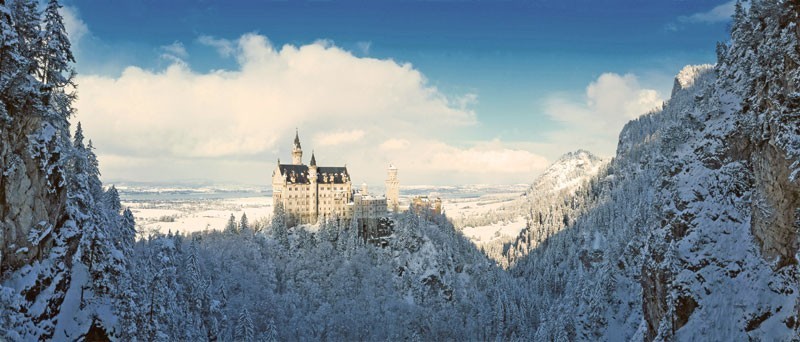
During the 19th century, Bavaria’s unconventional monarch, King Ludwig II, equipped his castles with cutting-edge technology.
Dining tables filled with food from the kitchen below were raised through the floor, internal communications systems were used to summon the servants and a grotto-shaped entertainment stage had the latest equipment capable of producing dazzling lighting effects and artificial waves.
The flamboyant king – who was thought to have been insane – built a fantasy world around him.
But whether Ludwig II was truly insane or simply eccentric remains a mystery.
The fairytale Bavarian castles that were born from his fertile imagination have become one of Germany’s top attractions, drawing curious crowds from around the world.
1- Neuschwanstein Castle
Of all the castles in Bavaria, Neuschwanstein Castle is Bavaria’s most impressive.
The Bavarian castle is perched high up on a hill and surrounded by Bavaria’s stunning mountain scenery, where in winter, the lush forest landscape transforms into a snowy wonderland.
Its romantic design with turrets and spires inspired Walt Disney’s Stardust Castle.
When visiting Neuschwanstein Castle, there are a couple of options.
From the foot of the hill, you can walk, board a minibus or a horse-drawn carriage to Marienbrücke, a bridge that crosses over the Pollat Gorge.
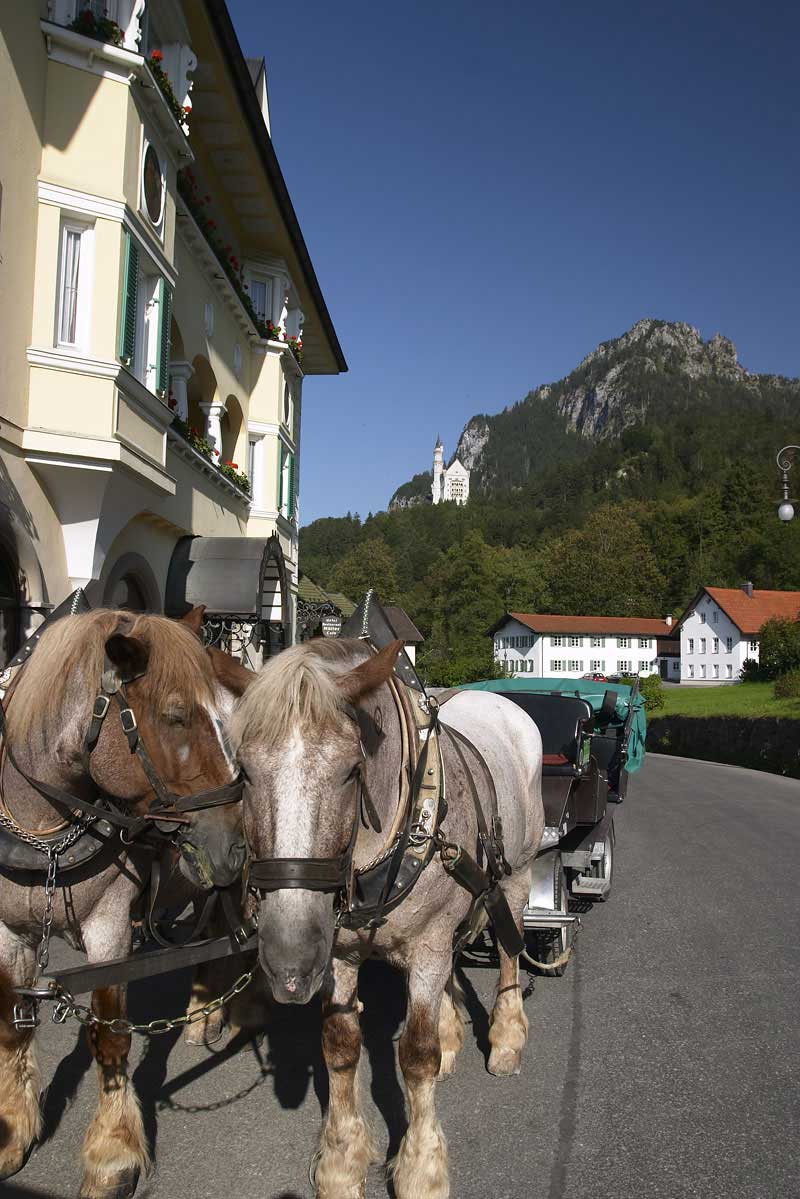
The castle is a 10-minute walk from the bridge.
The most romantic option is to hop on a horse-drawn carriage pulled by two magnificent workhorses that trot beneath the green canopy of the lush Bavarian forest, a mode of transport King Ludwig II himself would have used during the 19th century.
Built in the authentic style of an old German knights’ castle, some sections of Neuschwanstein are lavishly furnished while other sections were never completed.
The rooms and halls were equipped with the most up-to-date 19th-century conveniences, such as heating, running water, flushable toilets and a sophisticated internal communications system used to summon the servants.
The theme of the castle is operatic and the walls are adorned with paintings from Wagner’s (the king’s favourite composer) operas.
Gaze at the grand floor-to-ceiling scenes of the poet Tannhauser, the dashing knight Lohengrin and stately King Parsifal as you wander through the magnificent halls.
As Ludwig II identified with Parsifal, the castle’s throne room was built to resemble a stage set for Wagner’s last opera, Parsifal.
Wagner even went as far as to incorporate Ludwig II’s emotional issues into the Parsifal character in the opera.
Neuschwanstein Castle can be easily visited on a day trip from Munich. Here are some tips on how to get from Munich to Neuschwanstein Castle.
2- Hohenschwangau Castle
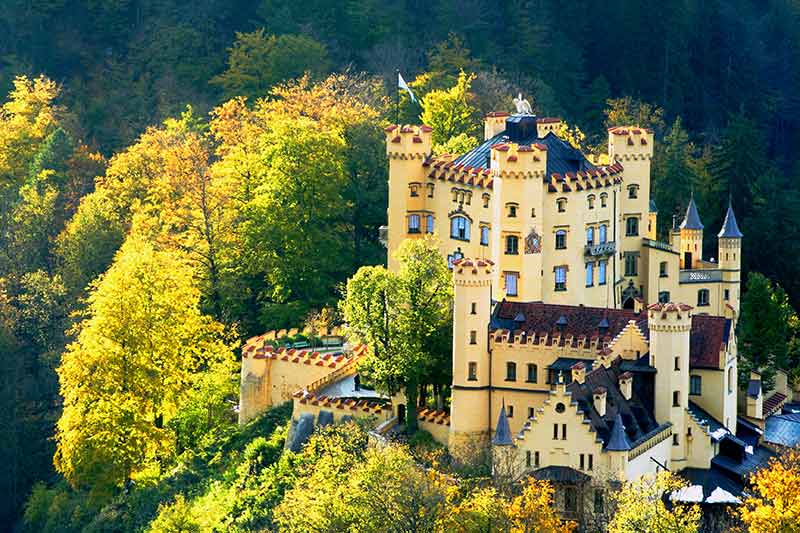
From various windows and balconies at Neuschwanstein, there are views of the neo-Gothic Hohenschwangau Castle, which sits on a hill across the valley and is where Ludwig II spent most of his childhood.
Inside the castle, the Hall of Heroes and Knights is an enormous hall that takes up the entire width of this castle.
Gothic columns soar up to the stucco ceiling, decorated with pink and silver neo-Gothic ornaments.
The Oriental Room is exquisitely decked out with ornaments from Greece and Turkey.
3- Linderhof Palace
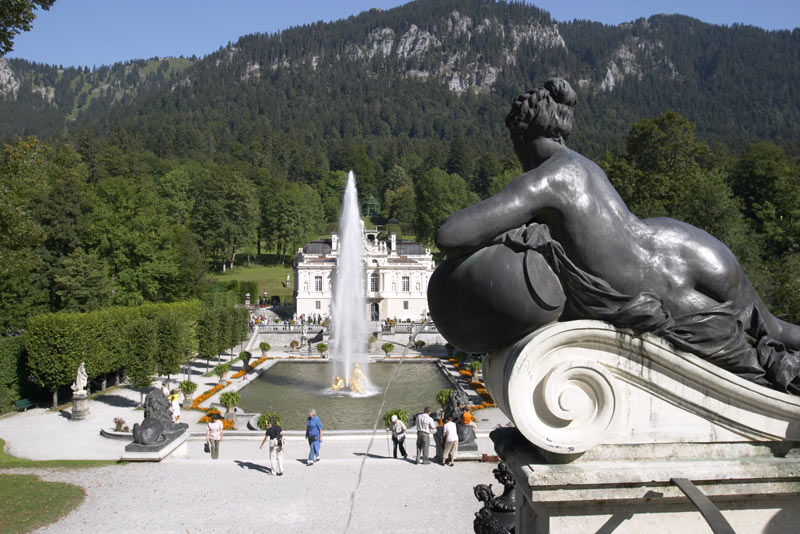
Although Neuschwanstein was the grandest of all his castles, Ludwig II’s main abode was at the refined Linderhof Palace, a royal residence modelled after the Palace of Versailles (one of the most famous landmarks in France).
Ludwig’s admiration of Louis XIV, France’s Sun King, is instantly recognizable in the design of Linderhof Palace.
The royal residence captures the spirit of French Baroque and Rococo styles with a smaller version of Versailles’s famous Hall of Mirrors.
At the entrance to the palace, there is a statue of the French king looking stately on his horse.
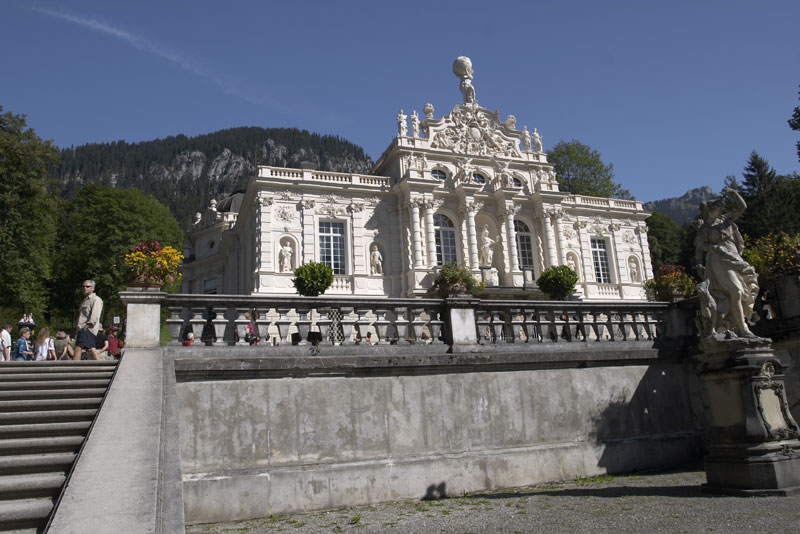
The Sun King’s symbol – a sun with rays – can also be spotted throughout the palace.
The centrepiece of the royal gardens is a glorious pool with a 25-meter fountain that splashes water on gold-gilded nymph statues.
Ludwig’s daily life was an operatic production.
During meal times, a long dining table rose through the floor laden with food from the kitchens below.
When he wanted to be entertained, musicians performed his favourite music in a swan-shaped boat that floated on a man-made lake at the Venus Grotto, an artificial cave and lake tucked away in the hills.
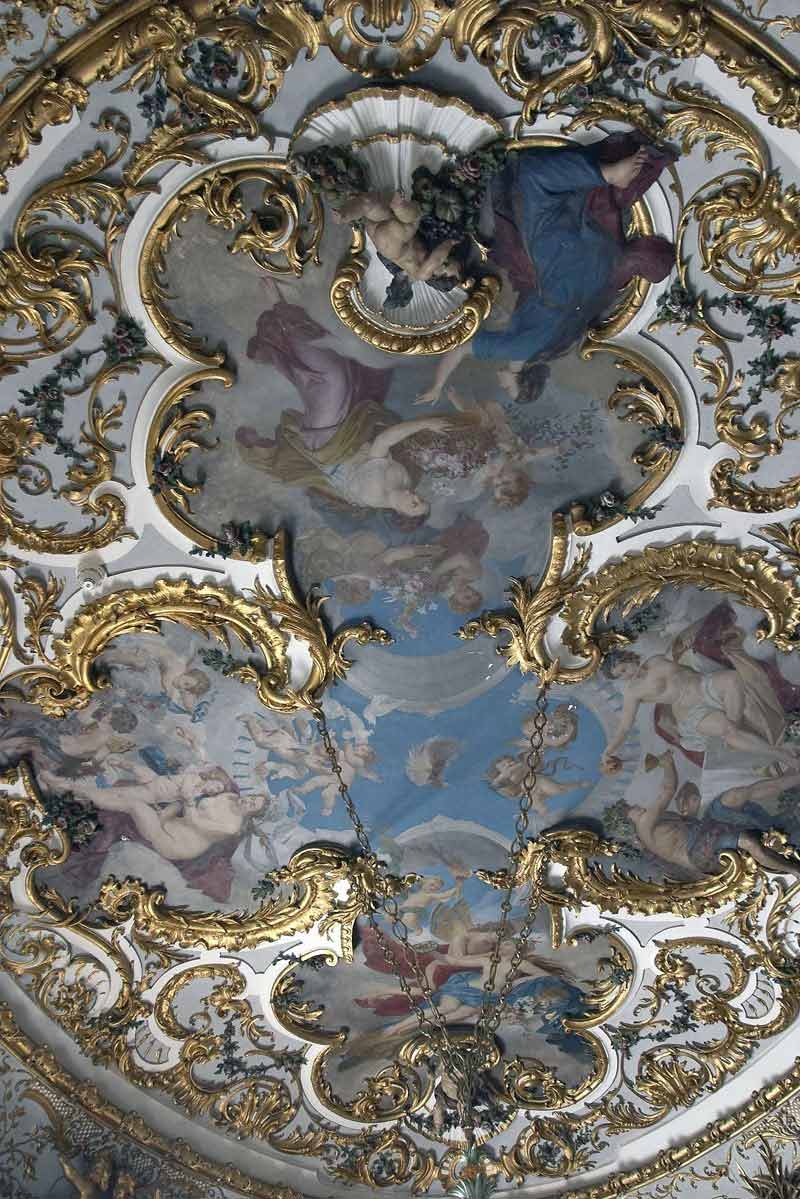
The Grotto was the king’s private stage and was technologically advanced for its time.
There were light displays with colourful special effects, a projector that re-produced waterfalls and a wave machine to generate artificial waves for the opera performances.
4- Herrenchiemsee Palace
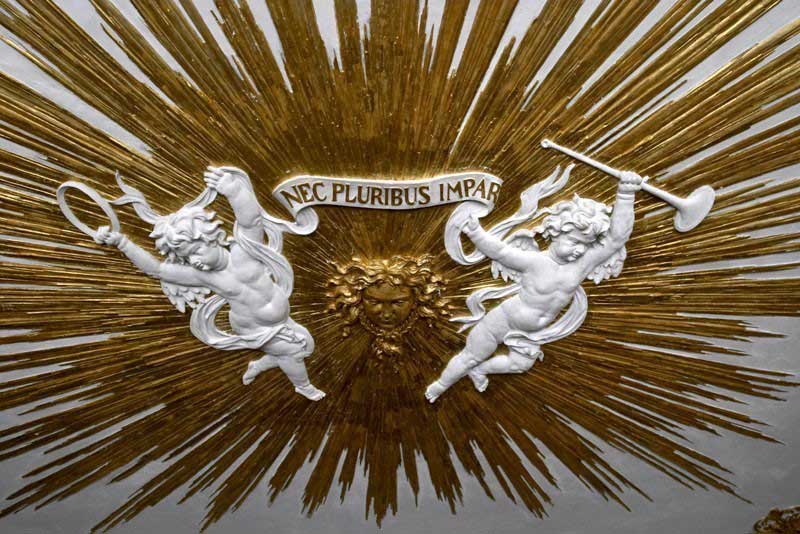
Ludwig II admired France’s Louis XIV so fervently that the Hall of Mirrors at Linderhof Palace was not enough.
Herrenchiemsee Palace was built on a 240-hectare island and modelled after the Palace of Versailles.
Among other decorations, the lavish palace was equipped with 52 candelabras, 33 chandeliers and tubs of orange trees.
Even though this palace was the largest of all the royal residences, Ludwig II only ever lived there for a total of one week.
Herrenchiemsee Palace’s never-ending Hall of Mirrors stretches for 98 meters, even longer than the original in Versailles.
It has a chandelier made of delicate Meissen porcelain, and like Linderhof Palace, the dining room also has a table that can be lowered into the floor.
Today, the King Ludwig II museum is located on the palace’s ground floor. Among other items on display are paintings, antique coins, a coronation cloak, original furniture from Linderhof Palace and the royal apartment of Munich’s Residenz.
5- Nymphenburg Palace
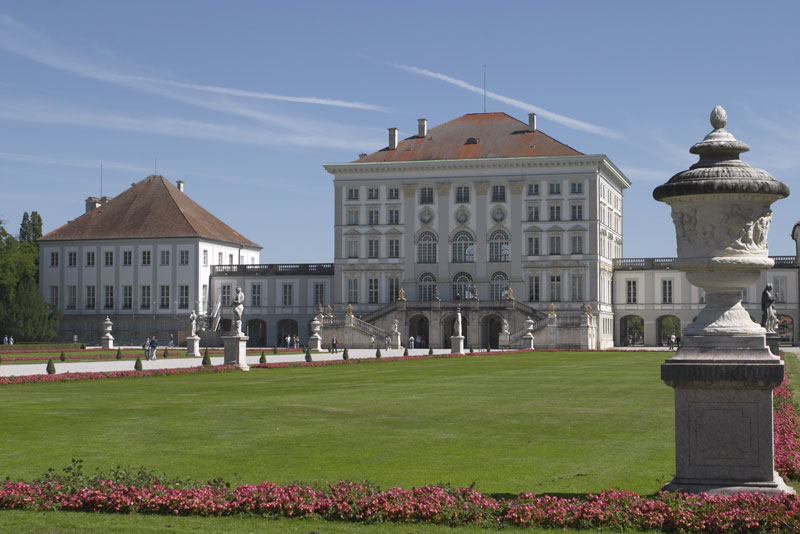
Visiting the palace is one of the most popular things to do in Munich as Ludwig II was born in Munich’s Nymphenburg Palace, the stately summer residence of five generations of Wittelsbach rulers since 1664.
The monarchy was overthrown in 1918 and the main palace for Bavaria’s Wittelsbach rulers, The Residenz, is now a museum.
The highlight of Nymphenburg Palace is its Gallery of Beauties, a gallery with paintings of court ladies and mysterious unknown beauties whom Ludwig II’s grandfather, Ludwig I, admired.
Although it was generally accepted for court ladies to be painted during those days, Ludwig I created an uproar by commissioning artist Joseph Stieler to paint common beauties.
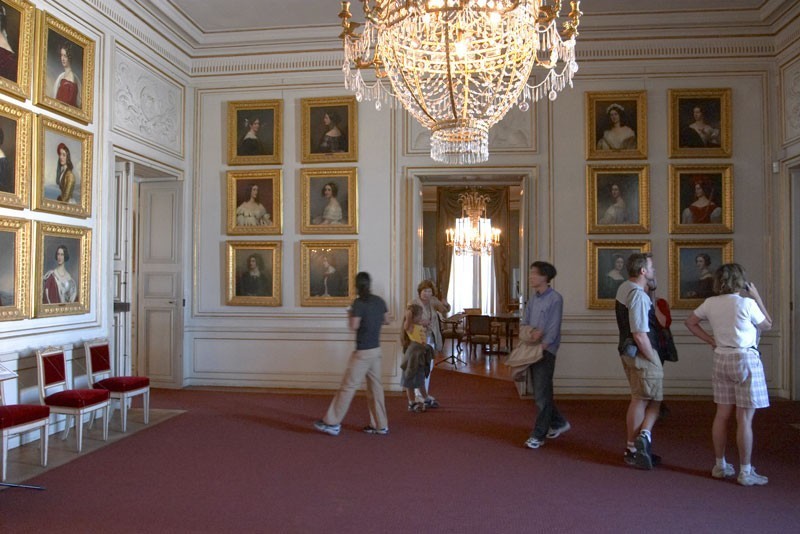
Nymphenburg Palace’s Baroque-style gardens are a reminder of the chivalrous days when finely dressed ladies and gentlemen strolled past fountains, statues, pavilions and colourful flowerbeds.
Also on the palace grounds is the royal hunting lodge, the Amalienburg.
Hunting was a favourite pursuit of the ruling class.
The luxurious lodge has a plush room with internal kennels to house the pampered royal dogs – was used as a day retreat during hunting season.
In 1886, Ludwig II decided to build another castle at a site on top of Falkenstein Mountain near Pfronten.
By this time, the people had become weary of his excessive lifestyle and his ministers plotted to remove him by declaring him insane.
Before they could carry out their plan, Ludwig II drowned mysteriously in Lake Starnberg while under house arrest at Berg Castle.
Although his last project will remain a dream forever, the legacy of royal castles and palaces Ludwig II left for Bavaria continues to inspire the imagination of millions of visitors.
Bavaria’s castles and palaces are some of the most impressive landmarks in Germany.
6- Schleissheim Palace

Schleißheim Palace is a complex of three palaces set among lovely gardens – the Old Palace, Lustheim Palace and the New Palace.
Built over successive generations starting in 1598, when Duke Wilhelm V of Bavaria turned his back on court life and moved to the countryside.
Old Palace
The Duke’s son (Maximilian) replaced the original manor with the Old Palace in 1617.
Although the Old Palace is the most modest of the three palaces, it’s worth a visit to understand the evolution of this impressive palace complex.
The Old Palace also houses the Schleißheim Museum, which is a branch of the Bavarian National Museum.
The main collections in the museum are the Gertrud Weinhold Collection, with its 6,000 items of religious culture, and the East and West Prussia Collection of 400 exhibits documenting the history and culture of East and West Prussia.
The Kingdom of Prussia once stretched beyond Germany to parts of Poland, Russia, Lithuania, Denmark and Belgium.
Lustheim Palace
Lustheim Palace is a beautiful Italian-style palace built when Max Emanuel (1680 to 1726) married Princess Maria Antonia, the daughter of the Austrian Emperor.
Henrico Zucalli built a royal hunting lodge and a garden palace, designed along the lines of popular 16th-century Italian casino buildings.
The palace is a branch of the Bavarian National Museum and is home to an exquisite collection of early Meissen porcelain.
On display are over 2000 pieces of 19th-century tableware, figures and animal figurines highlighting the lavish lifestyles and banquets of the Baroque era.
New Palace
The New Palace was a project of Max Emanuel, who began construction in 1701 but was exiled to Paris in 1714, during the Spanish War of Succession.
Work resumed when he returned to Bavaria in 1715 and Italian, French and Bavarian artists were commissioned to complete the palace.
The palace’s furnishings are a reminder of the days when sculpture, furniture making, metalwork were considered an art form.
The State Bedroom in the Apartment of the Electress has painted ceilings by Bavarian artist Cosmas Damian Asam.
Artwork from the State Gallery of European Baroque Art is displayed in the halls and apartments of this grand palace.
Schleißheim Palace is at Max-Emanuel-Platz 1, 85764 Oberschleißheim and can be accessed by train, bus or on an organised tour.
7- Nuremberg Castle
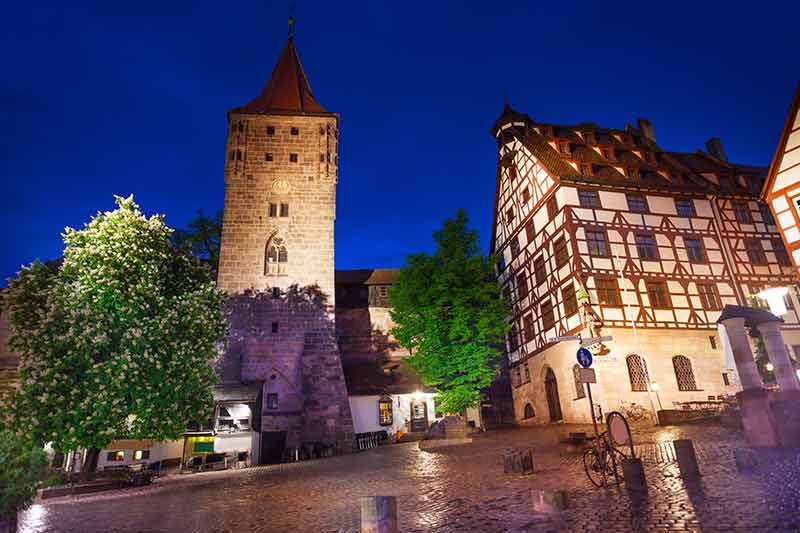
Although the city of Nuremberg is more famous for being the seat of Nazi power, the city also has a castle that dates back to the Middle Ages.
A 13th-century castle that sits above Nuremberg’s Old Town, this castle is a legacy of the Holy Roman Empire.
During the Middle Ages, Nuremberg was a major centre and a walking tour of Nuremberg Castle is one of the things you shouldn’t miss.
Highlights of this castle are its double Imperial Chapel, which is one of the oldest sections of the castle, royal residences, staterooms, the well and tower.
8- Plassenburg Castle
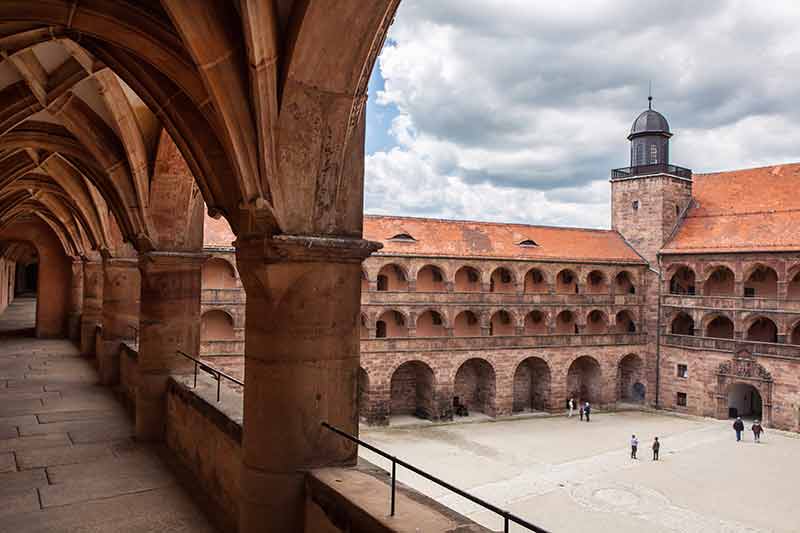
Plassenburg Castle in Kulmbach is a sprawling fortress belonging to the Hohenzollern family.
Work on the castle fortress started in 1338 and continued through to 1791.
The Schlosskirche (castle’s church) is used for religious services and the castle is available to book for weddings.
Plassenburg Castle is at Schloss-und Gartenverwaltung Bayreuth-Eremitage, Ludwigstraße 2, 95444 Bayreuth, Bavaria.
9- Burghausen Castle
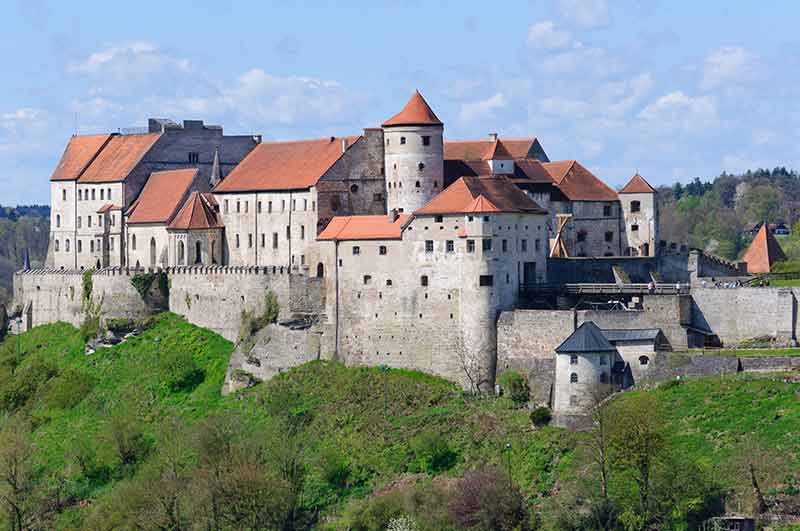
The striking thing about Burghausen Castle is that its medieval fortifications stretch for 1000 m, making it one of the world’s largest castle complex.
Built in 1255, Burghausen Castle was a residence of the dukes of Lower Bavaria and one of the best fortresses in Bavaria.
The castle’s chapel is in honour of St Elisabeth, who was devoted to the poor and the underdogs.
The castle is home to a collection of Gothic panel paintings that tells the story of Bavaria and there’s a viewing platform with fabulous views of the countryside.
Burghausen Castle is at Burg Nr. 48, 84489 Burghausen, Bavaria.
10- Aschaffenburg Castle
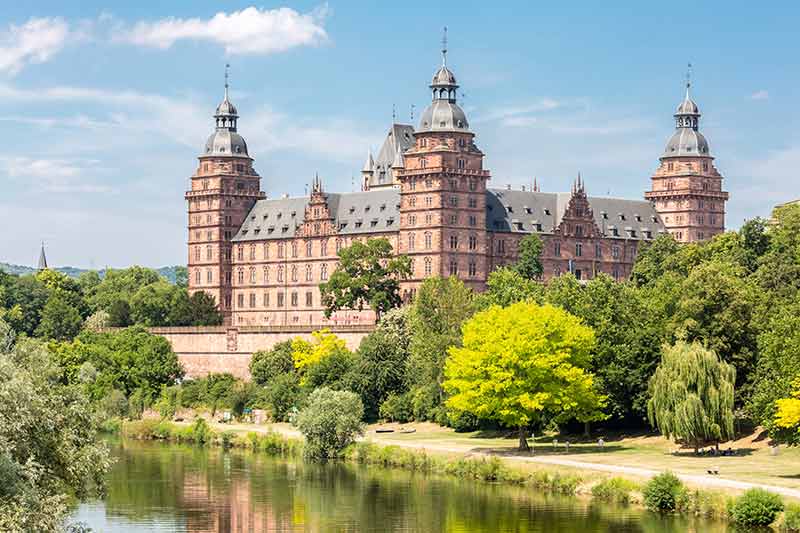
Aschaffenburg Castle is in northwest Bavaria and consists of three palaces – Johannisburg Palace, Ponpeiianum and Schonbusch Palace.
Johannisburg Palace
During the 19th century, Johannisburg Palace was one of the residences of the Archbishop of Mainz.
The German Renaissance palace sits by the Main River is a sprawling complex with four wings that were built between 1605 and 1614.
Like many other palaces in Bavaria, Johannisburg Palace went through later renovations that added to its original character.
The palace was redecorated in the Neoclassical style in the late 18th century and the exterior was completely restored after World War II.
Visit the art gallery and admire the Palace Church, which has a stunning altar, pulpit and portal sculptures from the Renaissance era.
This Bavarian palace is also home to the largest collection of cork architectural models in the world.
The 45 displays are reproductions of Italian landmarks from Ancient Rome, such as the Colosseum, Pantheon and triumphal arches.
Pompeiianum
King Ludwig I was so inspired by Pompeii that he built a grand Roman villa here during the 19th century.
The villa has displays of Roman marble sculptures, bronze artefacts and glass art from the Bavarian State Antiquities Collection and the Glyptothek in Munich.
Also on display are two marble thrones of gods.
Aschaffenburg Castle is at Schlossplatz 4, 63739 Aschaffenburg, Bavaria.
Schönbusch Palace
One of the best features of Schönbusch Palace is its landscaped gardens, which has eye-catching features such as a red bridge, observation tower and a small village with charming cottages.
A former deer park was transformed into a lovely English-style garden with a neo-classical summer residence for the Archbishop of Mainz, Friedrich Carl von Erthal.
Schönbusch Palace took a few years to build (from 1778 to 1782) and the garden was completed in 1790.
There are several day excursions to the castles departing from Munich with commentary in both English and German.
An organised tour is a relaxing way to see several Bavaria’s castles in a day, however, German tour guides operate according to precise schedules and anyone who doesn’t return to the bus at nominated departure times is likely to be left behind.
Best time to visit Bavaria
Avoid visiting the Bavarian castles in summer, especially in August, when there are long queues.
There is a delightful ambience in September when there are concerts in the Singer’s Hall at Neuschwanstein.
Looking for more castles? Try these:
Love castles? You’ll want to read about these:
Plan Your Trip

Rent A Car – Find the best car rental rates at Discover Cars. They compare car hire companies to provide you with the best deal right now.

Find A Hotel – If you’re curious about this article and are looking for somewhere to stay, take a look at these amazing hotels.

